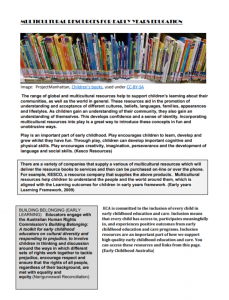28 Multicultural resources for early years education
Megan Higgs
Instructions
The purpose of this multicultural resource is designed to support educators with a tool that they can use in their planning or their daily practices. As suggested in the Early Years Learning Framework (EYLF) (Department of Education, Employment & Workplace Relations (DEEWR), 2009), aligning with outcomes 1 and 2: Children develop a sense of belonging when they feel accepted and when educators create environments in which children are connected. This helps children learn ways of ‘being’ which reflect values, traditions and practices of their families and communities (DEEWR, 2009). This resource provides educators with guidance of where they could access materials, resources or information that will support their cross-cultural experiences that they can share with the children, families and community partners. Utilising a variety of different cultural resources will enable the educators to assist children to see the point of view of others and appreciate cultural diversity. It will also assist in guiding children to respect the differences among people in their community and the world around them. Educators can research the variety of companies that have multicultural resources for purchase, or be inspired to create something similar themselves.
Rationale
Working constructively with families whose educational views and cultural values are different from those of the educator requires a great deal of care and thoughtfulness (Durand, 2016). Culturally competent educators celebrate the diverse cultures in the early learning service, and realise that this competence is more than just displaying flags or painting dots on a piece of paper. It means respecting, valuing and including all families and staff and engaging with the wider community to share authentic cultural experiences.
Inclusion is important for many reasons. It ensures that all children participate meaningfully while learning and interacting in programs that acknowledge each child’s culture, strengths and interests, so that they are supported to be active members of their community. Inclusion supports current thinking about child development; promotes children’s rights; assists in implementing the legal standards for early childhood education and care; and is good professional practice. Inclusion fosters diversity and overcomes any barriers that might exist to ensure that every child experiences quality early childhood education and care (Early Childhood Australia, n.d.).
Most children and young people in Australia grow up in a safe, healthy and positive environment. Children’s Rights in Australia brings together children, advocates and resources to advance children’s human rights in Australia (AHRC, 2016b). As early childhood educators, we share children’s lives, the family’s love for their children, we share their stories, share with open doors. This helps overcome language barriers and it promotes mutual respect. Sharing becomes a two-way exchange of experiences. A goal of working with families is to create partnerships founded on mutual respect. This means supporting the cultural identity for all children in the service. Sharing learning experiences with families opens pathways for discussion, which ultimately enhances children’s sense of belonging.
Links to the NQS, EYLF learning outcomes, and QKLG
The above resource aligns with the National Quality Standards (NQS): Quality Area 1- Educational program and practice; and Quality Area 6- Collaboration partnership with families.
The resource also aligns with the Early Years Learning Framework (EYLF) (DEEWR, 2009) learning outcomes: Outcome 1- Children have a strong sense of Identity; Outcome 2- Children are connected with and contribute to their world; and Outcome 4- Children are confident and involved learners.
Additionally, the resource meets the Queensland Kindergarten Learning Guidelines (QKLG)- Identity, Connectedness and Active Learning.


